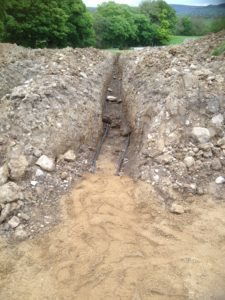Much as we’d like to have bought our own excavator, the budget wouldn’t quite stretch to it! Luckily a neighbour recommended a very good local contractor Andrew, who had a range of excavators for all occasions and made it look very easy.
As we had no mains drainage connection, as noted in a previous post we opted to install a package treatment plant to deal with our sewage on site. This not only required a 2.4m deep hole to contain the tank, but a further soakaway for cleaned water to discharge to, and 150m trench for the drains to run from the house to the plant. We laid the drains ourselves, and surrounded them with pea gravel before backfilling. Due to the length of drains, Building Regulations require inspection chamber at regular intervals, to provide access in case of blockages. As we had kept the trench as narrow as possible, we had to widen it by hand for the inspection chambers which was quite time consuming.
To avoid overwhelming the package treatment plant, we also had to install a second set of drains for the surface water. Roofing works were still underway so we hadn’t yet fitted guttering, but we could at least get the drains laid and inspection cover at every junction and change of direction. An oversized soakaway was also excavated, as percolation tests revealed high clay content which is not the best soil type for soakaways. The soakaways are wrapped in a geotextile fabric to prevent soil clogging them up, and filled with free draining granular hardcore. We had lots of concrete footpaths and shed bases to break up, so these all disappeared into the soakaways before being covered with 400mm of top soil.
We also plan to dig a natural swimming pond that will be filled with rainwater, to encourage wildlife. But this will be in a year or two, when work on the house has progressed further. There are some great organic pool designs now, that are chemical free and use the plant life to filter the water. This will hopefully be the subject of a post in its own right, when we’ve done our research.
By far the largest excavation project was for the ground source heat pump. To gather enough “heat” from the ground, we had to dig 7no. trenches that were 1m deep 1m wide and 50m long. These trenches then had to be lined with sand by hand (to protect the pipes from stony ground), and all terminated in a manifold chamber before a single trench ran up to the house and into the utility room. We then built a blockwork structure on a concrete base to house the manifold, the pipework was then filled with brine and pressure tested.
More sand was then used to cover the pipes, before the trenches were backfilled. Where drains passed over these ground loops, we had to lay insulation between them to stop the drains freezing if the ground temperature dropped too low due to the heat being absorbed by the brine. We nervously watched the pressure gauge as the pipes were backfilled, as a puncture would be very difficult to trace. Thankfully there were no problems, and the pipework should now be “safe” from damage.
The borehole drilling contractor also had to dig a shallow trench from the borehole, up the field to where the storage tank and filtration was housed in our barn. The trench back filled the same day, so the only lingering spoil was from the actual drilling which went in a mini skip a week or two later.
Whilst we had Andrew and his digger on site, we also broke up several areas of concrete footpaths and hardstanding. Not only did this provide lots of hardcore for the soakaways, but it enabled us to improve gradients into the barn and lower the ground level around the house. When excavating, it was clear to see that the ground level had been raised over the years with different layers being added, which was encouraging damp up the walls.
Our previously lovely green field was now a sea of brown topsoil, but we have sown a meadow mixture of native wildflowers and grass seed to repair the damage. For the gardeners out there, we seeded White Campion, Field Forget Me Not, Nettle Leaved Bellflower, Scarlett Pimpernel, Self Heal, Common Vetch, Hoary Plantain, Corncockle, Chamomile, Corn Flower, Marigold and Poppies. Fingers crossed !











